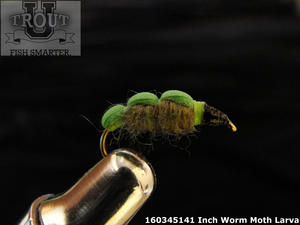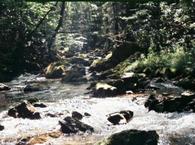
Terrestrial insects, including ants, beetles, houseflies, bees, spiders, crickets, grasshoppers, worms, moths and more do not intentionally spend any of their life cycles in the water. The only time that they get in the water is when they land in the water accidentally, helped by the wind, rain or snow. Contrary to popular belief, they do not constitute a large part of the trout’s diet; in fact, it is believed that they may be only 1% of their diet.
The degree of their importance in the trout’s diet depends somewhat on the quality of the aquatic insect population, the seasons, and the environment where the stream is located, for example: trout living in a stream running through a meadow will be more likely to take a terrestrial fly.
Trout primarily eat the aquatic insects in the adult stage or in the larvae or the nymph states. Also, on the trout’s menu will be the baitfish, sculpins, and crustaceans which are available year around. At any one point in time, when you observe the surface of a stream, you will not see many terrestrials floating there. Well, where does that leave terrestrials on the trout’s menu? When a free and somewhat large free meal accidentally fall into the water rand is positioned where the trout need not expend much energy, he may not be able to resist it, so terrestrials should have a place in your fly box.
The impact of seasons will be the greatest factor in deciding when to use an imitation of a terrestrial. In the summer, the water becomes warmer, and many of the hatches slow down causing the trout to be more inclined to take a terrestrial imitation. Also, the habits and the life cycles of the terrestrials in the summer season make them available for the trout to eat, for example: the larvae of moths and other insects can be seen in the trees and vegetation along the banks throughout the summer.
The weather can be a big factor and as we have mentioned above, the wind and the rain will cause more terrestrials to fall into the trout stream. The feeder streams will carry terrestrials like worms, ants, beetles along and empty them into the trout stream. When you see a swollen feeder stream emptying into a trout stream, the potential for terrestrials and the different temperature of the incoming water may trigger interest in the trout. Therefore, these feeders will present an excellent opportunity to fish the seams with the terrestrial pattern.
The environment will help you select the best imitation terrestrial pattern. If the stream flows through meadows, as they often do in the Yellowstone National Park, you can expect the grasshoppers and the crickets to be a factor in the trout’s diet. If you are in the mountains, there may be opportunity for the crickets, ants and the beetles to be blown into the water.
The activity near the trout stream is a factor as well. If the stream in near or below a road, the wind from the passing cars will cause more terrestrials to hit the surface of the water. Also, if there is roadside mowing or a farmer mowing an adjacent field, you can be sure there will be terrestrials hitting the surface of the water. This happened to me once on the Cataloochee Creek.
Trout don't normally become totally selective eating only one type of food; rather, they are opportunistic feeders. They will focus on the food that gives them the most benefit for the least amount of energy at that particular point in time. Remember, to consistently improve your catch rate, fish imitations of the food that is most readily available and easiest for the trout to acquire at that particular point in time.
A dropper fly will benefit you by making the fly more visible to you the angler especially late in the day. For example, to a size 14 foam hopper tie an additional eighteen inches of line attached to a size 18 beetle or ant imitation to become a dropper fly. You will probably notice that 75% of the time the trout will take the dropper fly and leave the hopper alone. This is an indication of the effectiveness of the dropper fly.
The better you are able to imitate the appearance, the colors and the behavior of their food, the more success you will enjoy. For that reason, we recommend the “Perfect Fly” line of flies and for more ways to fish with a hopper check out “Fly Fishing with Grasshoppers”.





